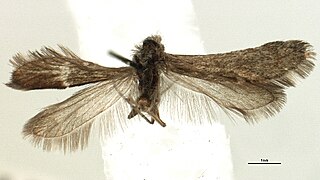
Lepidoptera or lepidopterans is an order of winged insects which includes butterflies and moths. About 180,000 species of the Lepidoptera have been described, representing 10% of the total described species of living organisms, making it the second largest insect order with 126 families and 46 superfamilies, and one of the most widespread and widely recognizable insect orders in the world.

The Pterophoridae or plume moths are a family of Lepidoptera with unusually modified wings, giving them the shape of a narrow winged airplane. Though they belong to the Apoditrysia like the larger moths and the butterflies, unlike these they are tiny and were formerly included among the assemblage called "microlepidoptera".

The Nymphalinae are a subfamily of brush-footed butterflies. Sometimes, the subfamilies Limenitidinae, and Biblidinae are included here as subordinate tribe(s), while the tribe Melitaeini is occasionally regarded as a distinct subfamily. Their phylogenetics can be traced back to the Cretaceous Terrestrial Revolution after the Cretaceous-Paleogene (K-Pg) mass extinction, followed by repeated dispersals into the rest of the Old World and the New World during various periods beginning in the Eocene.

Heterobathmia is a genus of Lepidoptera. It is the only genus in the suborder Heterobathmiina, as well as in the superfamily Heterobathmioidea and in the family Heterobathmiidae. Primitive, day-flying, metallic moths confined to southern South America, the adults eat the pollen of Nothofagus or southern beech and the larvae mine the leaves. Most known species are undescribed.

Lophocoronoidea is a superfamily of insects in the order Lepidoptera. There is a single extant genus, Lophocorona, in the family Lophocoronidae. These are small, primitive nocturnal moths restricted to Australia whose biology is largely unknown.

Yponomeutoidea is a superfamily of ermine moths and relatives. There are about 1,800 species of Yponomeutoids worldwide, most of them known to come from temperate regions. This superfamily is one of the earliest groups to evolve external feeding and to colonize herbs in addition to shrubs and trees.

The Hepialoidea are the superfamily of "ghost moths" and "swift moths".
Coelolepida is a clade of insects in the lepidopteran order, containing the infraorders Acanthoctesia, Lophocoronina, Neopseustina, Exoporia and Heteroneura, with the latter three grouped in clade Myoglossata.

The Arctiini are a tribe of tiger moths in the family Erebidae.

The Xyelidae are a comparatively species-poor family of sawflies, comprising about 80 extant species in five genera worldwide, and is the only family in the superfamily Xyeloidea. The fossil record of the family is extensive, comprising more than 120 species and including the oldest fossil Hymenoptera species dating back to the Triassic, between 245 and 208 million years ago. Xyelidae are to be regarded as living fossils since they represent one of the oldest lineages of insects and include still extant forms.

Cyatholipidae is a family of spiders first described by Eugène Simon in 1894. Most live in moist montane forest, though several species, including Scharffia rossi, live in dry savannah regions. They occur in Africa, including Madagascar, New Zealand and Australia, and one species in Jamaica. Most members of this family hang beneath sheet webs. Fossil species occur in the Eocene aged Bitterfield and Baltic Ambers, suggesting a wider geographic distribution in the past.
Agathiphaga is a genus of moths, known as kauri moths. and is the only living genus in the family Agathiphagidae. This caddisfly-like lineage of primitive moths was first reported by Lionel Jack Dumbleton in 1952, as a new genus of Micropterigidae.
Elsornis is a genus of enantiornithine bird. Only one species is known, Elsornis keni. It lived during the Late Cretaceous. It is known from a partially articulated fossil skeleton found in the Gobi Desert in Mongolia.
Noctuites is a genus of extinct moths in the Noctuoidea superfamily. This genus was originally designated to accommodate noctuids of uncertain association. Most noctuoid fossils are incomplete, making them hard to place in a modern phylogeny of Noctuoidea. For this reason the genus has not been assigned to a family.

Merrifieldia is a genus of moths in the family Pterophoridae. It has an Old World distribution, with species known from Asia, Africa and Europe.
Auliepterix is an extinct genus of small primitive metallic moths within the family Micropterigidae. The genus is represented by two species, the type species A. mirabilis in the Karabastau Svita of the Upper Jurassic of Kazakhstan and Auliepterix minima in Upper Jurassic-Lower Cretaceous rocks near Khotont Somon in the Mongolian People's Republic.
Netoxena is an extinct genus of moths within the family Eolepidopterigidae, containing one species, Netoxena nana, which is known from the Crato Formation of the Araripe Basin in northeastern Brazil. Its generic name was originally Xena Martins-Neto (1999); however, this name turned out to be preoccupied by a genus of chloropid flies Xena Nartshuk (1964). A replacement generic name Netoxena was coined in 2012.

Onychopterellidae are an extinct family of eurypterids. The family is the only family classified as part of the superfamily Onychopterelloidea. Genera included are Alkenopterus, Onychopterella and Tylopterella.

Moselopteridae are an extinct family of eurypterids. It is the only family classified as part of the superfamily Moselopteroidea, and contains three genera: Moselopterus, Stoermeropterus and Vinetopterus.

NGC 1132 is an elliptical galaxy located in the constellation Eridanus. The galaxy was discovered by John Herschel on November 23, 1827. It is located at a distance of about 318 million light-years away from Earth.













